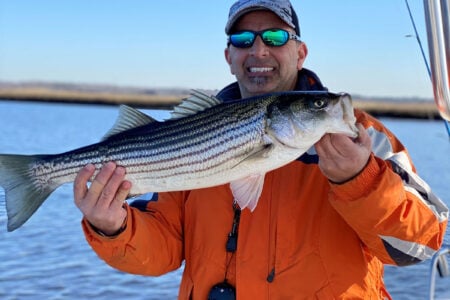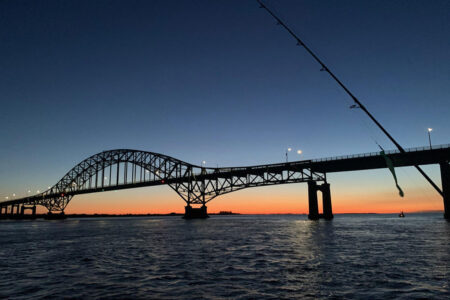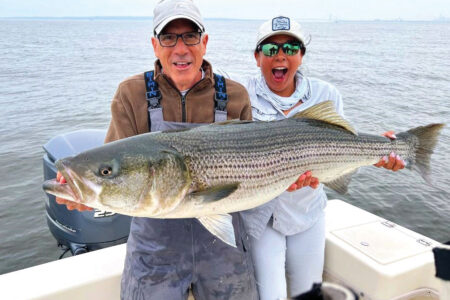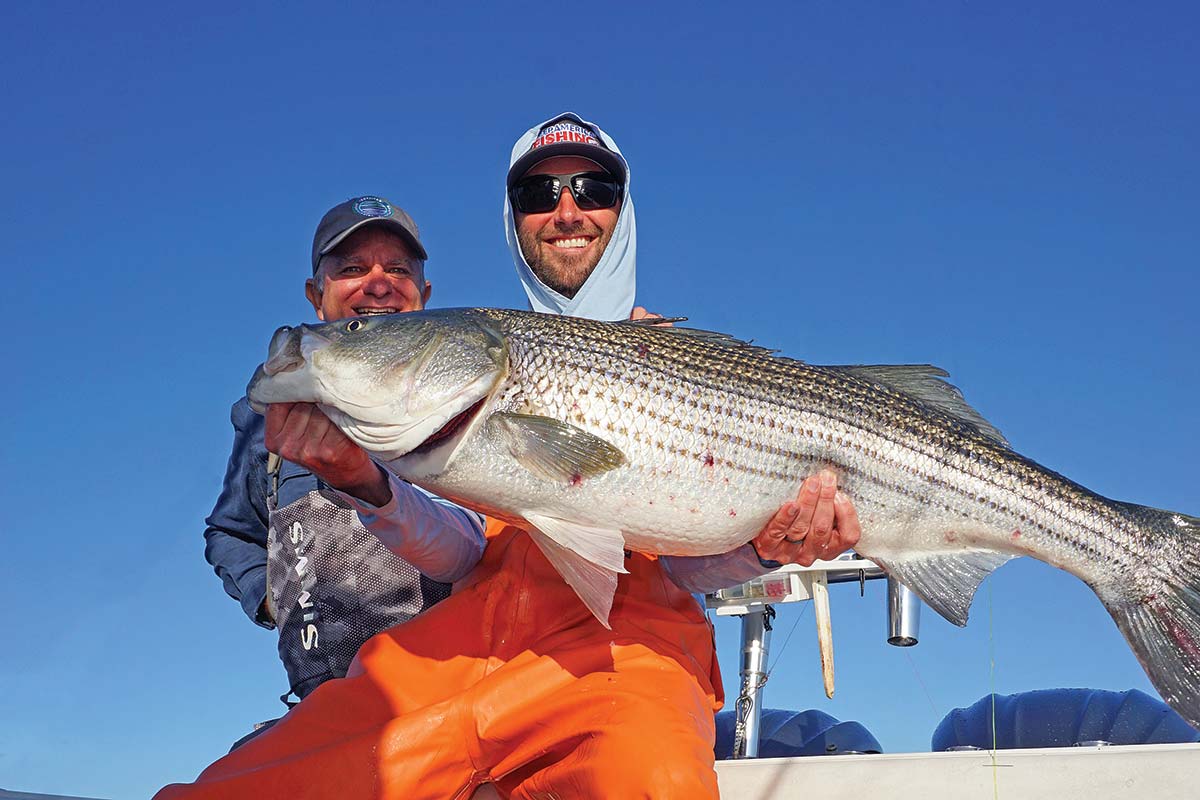
How and why the new 28” to 31” striped bass regulation came to be.
In a surprise vote by the Atlantic States Marine Fisheries Commission (ASMFC) and its Atlantic Striped Bass Management Board (Board) on May 2, 2023, fisheries managers directed all ocean states to modify recreational striped bass regulations to adopt a one fish bag and a 28- to 31-inch size limit.
In an official press release issued the following day, ASMFC’s Tina Berger said the emergency order to incorporate a 31-inch maximum size coastal limit for 2023 was made to reduce the directed harvest of the strong 2015 year class. “The 31-inch maximum size limit applies to all existing recreational fishery regulations where a higher (or no) maximum size applies, excluding the May Chesapeake Bay trophy fisheries which already prohibit harvest of fish less than 35 inches,” Berger said.
States have until July 2 to adopt the new slot measures, which are to remain in place through until at least October 28. “If it deems necessary, the Board may extend the emergency action for two additional periods of up to one year each at a future Board meeting,” said Berger.
“This action responds to the unprecedented magnitude of 2022 recreational harvest, which is nearly double that of 2021, and new stock rebuilding projections, which estimate the probability of the spawning stock rebuilding to its biomass target by 2029 drops from 97% under the lower 2021 fishing mortality rate to less than 15% if the higher 2022 fishing mortality rate continues each year,” Berger added.
The emergency action does not affect commercial harvest as it’s related specifically to the outstanding run of slot-sized striped bass in some areas along the Striper Coast in 2022 causing the Marine Recreational Information Program (MRIP) numbers to swell above the previous government forecasts. In an April 17th memo to the Board from the Atlantic Striped Bass Technical Committee and Stock Assessment Subcommittee, the preliminary MRIP data for 2022 indicate a 91% increase in recreational harvest and a 3% increase in recreational live releases when compared to the 2021 recreational fishery.
When both harvest and dead discards are combined, this results in an overall 40% increase in recreational removals, estimated at 6.2 million dead stripers in 2022 compared to 4.4 million dead fish in 2021.
And very much like the current political climate in the United States today, opinions were mostly split between “party” lines, with the exclusively catch-and-release community of striper anglers embracing the new, lower slot threshold, while those who enjoy targeting stripers for the table railing against the process.
As in most emotionally charged, highly political debates, there’s more than meets the eye here!
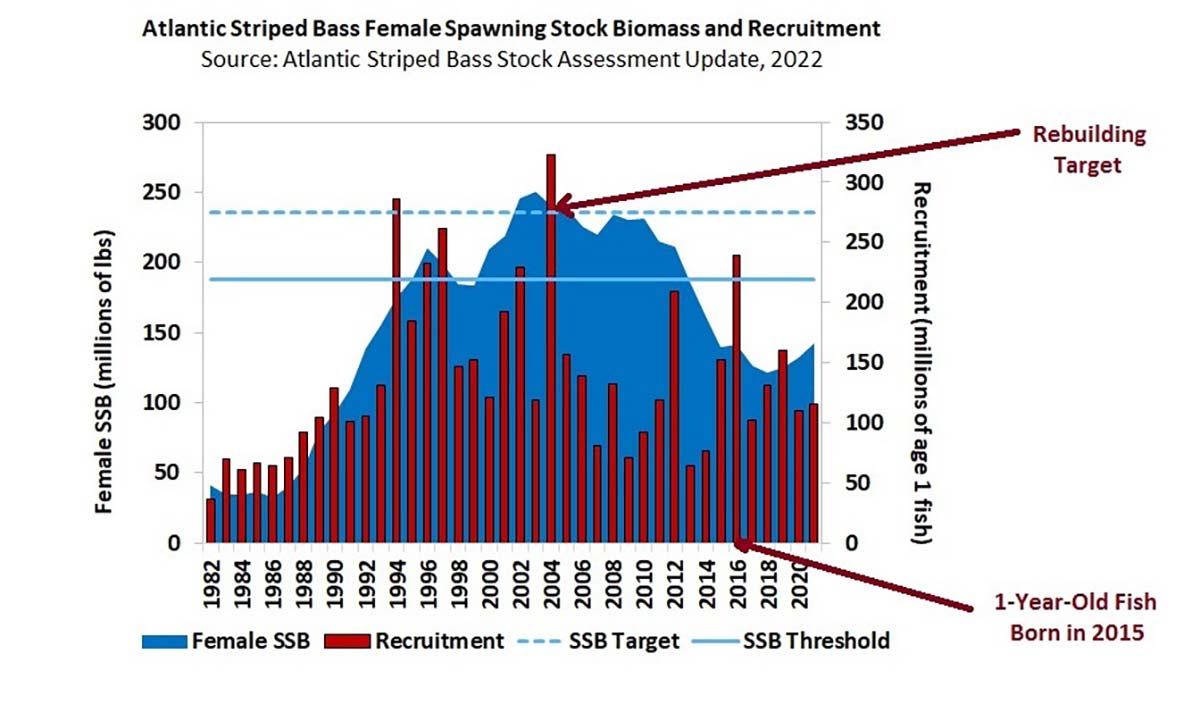
On The One Side
The ASMFC’s bombshell vote came by way of a motion by Dr. Michael Armstrong of the Massachusetts Division of Marine Fisheries and was seconded by David Borden from Rhode Island. A final vote in favor of the Massachusetts-led emergency action was approved by a 15-1 vote, with the sole opposition coming from the state of New Jersey.
The rationale for making this emergency declaration is tied to a perfect storm of sorts on three converging fronts. The first is that striped bass is considered “overfished” meaning that managers are working under authority to rebuild the spawning stock biomass (SSB) to 235 million pounds of spawning fish by 2029. According to the ASMFC, SSB was estimated to be 143 million pounds back in 2021.
To reach that 2029 deadline, fishery managers need to keep striped bass harvest and overall fishing mortality at a very low level in order to achieve that very high spawning stock biomass target. Thus, the second storm front is the fact that the striped bass fishery was so good in 2022 that recreational fishermen caught more fish than the managers expected, or “nearly double that of 2021” as Berger noted in the ASFMC release.
Strangely, the technical data coming out of the ASMFC only registered a 3% increase in the number of stripers released; and while that is good news that dead discards only went up marginally, thinking back on the fall run of stripers along the Jersey Shore in particular in November of 2022, it doesn’t seem to make sense to me. It doesn’t necessarily make sense to Mike Waine Atlantic Fisheries Policy Director at the American Sportfishing Association (ASA) either.
“In 2022, stripers were widely available and highly sought after. As a result, it’s difficult to understand how MRIP picked up on the harvest signal, but completely missed an expected increase in releases,” Waine said, adding “This type of comparison is not playing to MRIP’s strengths either so likely no one is surprised because the data are known to be uncertain.”
It’s important to keep in mind that there are two sources of recreational fishing mortality – fish that are kept and never make it back to the water, and 9% of released striped bass that are assumed to have died from the interaction, referred to as dead discards. Thus, more anglers participating in a fishery during times of abundance – and more fish being caught and released – that should theoretically result in an increase in discard mortality through MRIP.
Personally, or perhaps rather anecdotally, I had the best fall fishing of my life this past year, with double-digit catches on many trips to the beaches from Sandy Hook down south to Bay Head at the Jersey Shore, yet I personally took just one bass home during the fall run (my annual Thanksgiving striper). Folks traveled far and wide to the Jersey Shore last fall, arriving by the truckload from New York, Pennsylvania and parts unknown, with many new fishermen getting into the fishery for the very first time. I heard it, I saw it, and I reported on it! So considering the sheer number of blitzing bass in the surf practically every single day in November, wouldn’t it stand to reason that release numbers should have been measurably higher than previous years? Add that do the “data uncertainty” pile for now, but I digress.
Which brings us to the third and final front in the striper storm. The latest striped bass stock assessment estimated that strong year classes occurred in 2011, 2014, 2015, and 2018. Of particular interest to the ASMFC Board members is the 2015 year class. According to biological data used by fisheries managers, those 8-year-old spawning striped bass are now in the 31- to 32-inch range. As the largest year class over the past 10 years, Board members decided on May 2 that by immediately lowering the maximum size limit in the ocean fishery to 31 inches that it would give protection to that particular year class of fish, as well as age 9 and age 10 (33- to 36-inch fish respectively) now being over the slot size.
In theory, this action immediately adds more spawning stock biomass into the fishery .
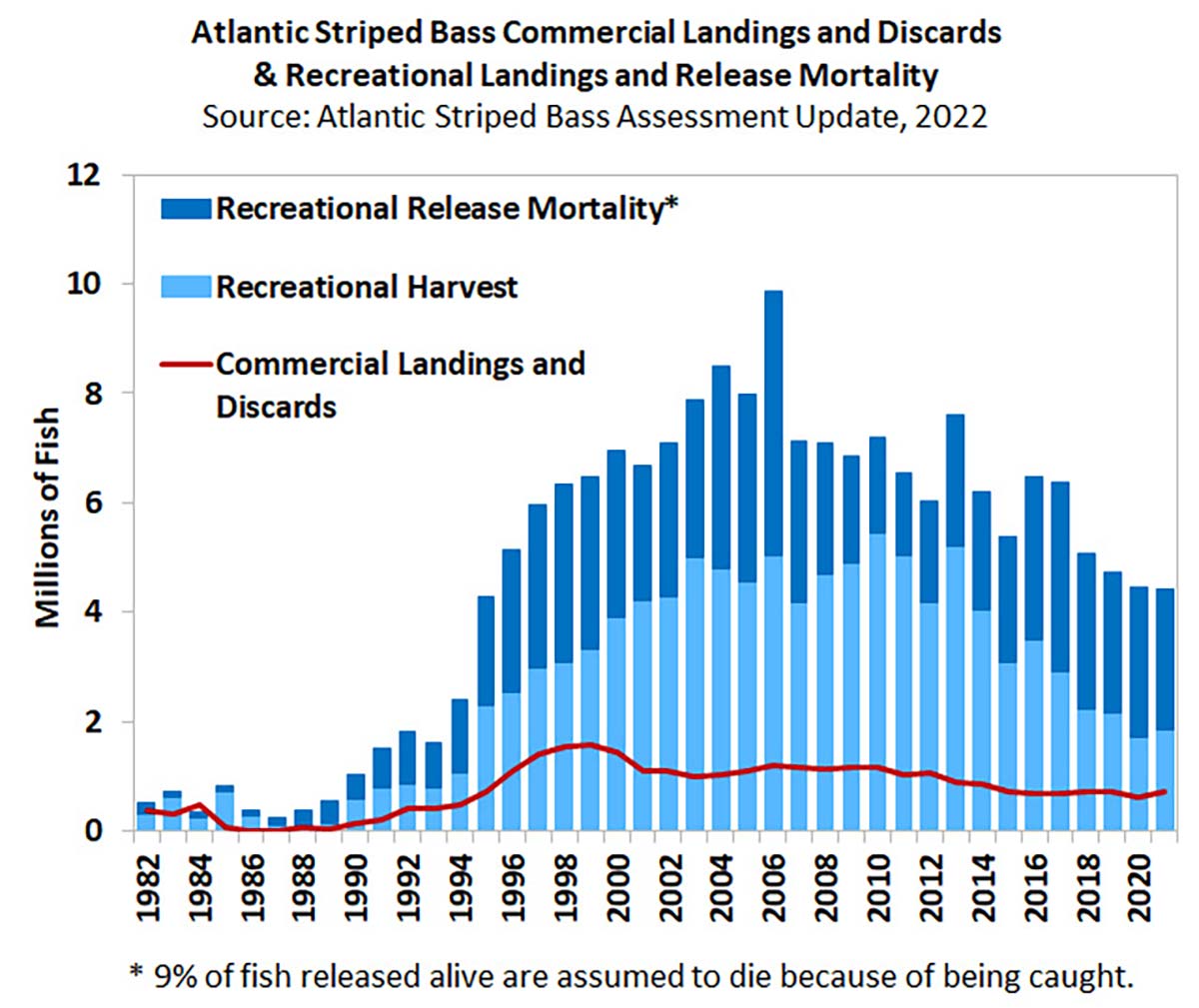
And Now The Other
So now that coastal states are rapidly coming into compliance with the new 28- to 31-inch striper size mandate, it might be worth a look at that 3-inch slot of striped bass now marked as the table target. Concentrating harvest on smaller, poorer year classes could very well have unintentional consequences that the Board did not have time to consider; but now could and should.
The last time the ASMFC took such action related to an exclusive year class was in 1985 when the commission focused its attention on protecting the 1982 class of female fish, leading to efforts to prevent the directed mortality rate on at least 95% of that year class, with some states actually imposing a total moratorium on striped bass fishing. That decision a year after the passage of the Atlantic Striped Bass Conservation Act in 1984 saw implementation of minimum size limits below which 95% of female stripers had spawned at least one time.
According to Waine, who spent five years working for the ASMFC coordinating fishery management plans on striped bass prior to joining the sportfishing industry’s trade association, whenever minimum and/or maximum size limits are adjusted it results in conserving some year classes more than others. “Emergency action is designed to reduce harvest overall and especially harvest on the 2015 year class,” Waine said, adding “However, concentrating harvest with a narrow slot that targets a couple poorer year classes was not something that the technical committee analyzed.”
Waine said that as states rapidly respond this month to the emergency action and the July 2 deadline, he also stressed that the ASMFC should be doing their due-diligence to collect the necessary statistical, biological and socioeconomic data related to this mid-year management change, adding, “we are encouraging the ASMFC technical committee to conduct the standard type of analysis they would do for any conservation measure on striped bass.”
The latest assessment and the 2029 deadline shows we have to reduce total removals, which is the number striped bass harvested plus the number of dead discards. The problem is that management has few mechanisms for reducing dead discards. In fact, many of the current measures to address release mortality (circle hook mandate when fishing with natural baits, no gaffing, no snag-and-drop on bunker schools) has no direct measurable benefit to addressing dead discards, only theoretical.
As it stands today, without regulatory control on dead discards, the conservation burden falls on the harvest side of the equation. The only tools that would likely be measurable are no targeting closures where fishing effort for striped bass is prohibited. Although impossible to enforce, it’s certainly not outside the realm of possibilities in order to rebuild striped bass to such a high magnitude. In fact, it was during the May, 2022 ASMFC meeting that state-by-state, two-week striped bass target closures which had been debated during numerous public hearings were officially voted down, as were proposed spawning area target restrictions.
Perhaps the latest emergency action however is the proverbial “writing on the wall” of regulatory burdens to come. In addition to the emergency regulatory decision, the Board also initiated potential changes to the management plan for striped bass which will consider more permanent measures in 2024 that better achieve rebuilding. “Specifically, the Draft Addendum will propose options for the ocean recreational fishery, including modifications to the slot limit with harvest season closures as a secondary non-preferred option,” the ASMFC release stated, adding that the new addendum would also propose options for the Chesapeake Bay recreational fisheries, as well as all commercial fisheries, including maximum size limits.
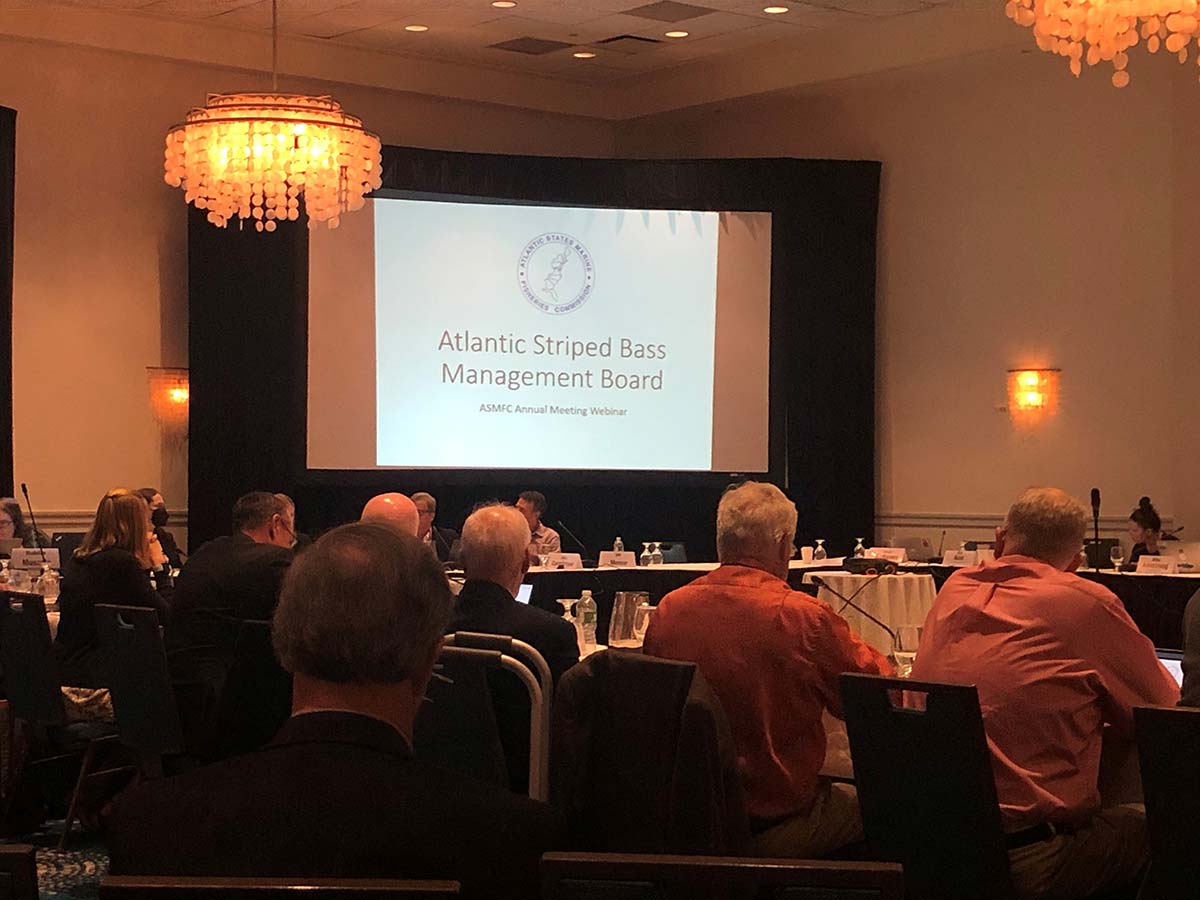
The Public Process
In essentially declaring a state of emergency on striped bass back in May, the ASMFC and its Striped Bass Management Board gave no advance warning and considered very little public comment before taking the vote. However, according to Board chair Marty Gary with the Potomac River Fisheries Commission, the ASMFC’s action was based in part on input from some members of the recreational community. “The public is concerned about stock rebuilding and has urged the Board to expeditiously respond to the new stock projections,” Gary said in the ASMFC’s official notice.
In an April 17, 2023 letter to the ASMFC supported by recreational fishing industry businesses like Simms, Temple Fork, Costa, Van Staal, Patagonia, Hogy, Cortland, Bajio, and Surfcasters Journal, the American Saltwater Guides Association (ASGA) encouraged the Board in advance of the May meeting to take such action. “Today, we believe that the striped bass fishery is at an inflection point: if action is not taken at the upcoming May meeting, the stock will not rebuild by 2029 and drastic measures may become warranted,” wrote ASGA vice president and policy director Tony Friedrich.
“The current rebuilding plan has failed,” Friedrich said, adding “Taking a correction now is far better than draconian measures in a few years.”
Calling striped bass “one of the flagship species” at the ASMFC, Gary said the action sends a strong signal that the Board is firmly committed to rebuilding the stock for current and future generations. “At the same time, the Board recognizes that this action will have a profound impact on the for-hire industry and recreational anglers, however, it feels it is a necessary step to ensure rebuilding,” Gary added.
However, according to Waine who was in the room during the ASMFC Board meeting and vote, it was evident that public comment was not the basis for the emergency action. “If it were, ASMFC would have provided more opportunity for the public to actually comment,” Waine said, adding “I’ve been to many of these meetings, and value the opportunity to provide industry input. For this action, meeting logistics were more important than allowing comment and that’s a failure of the process and its participants in which that process exists for.”
Waine said the Board’s decision shows a more conservative approach by ASMFC to managing striped bass in the future. “They have clearly indicated that through their action today,” Waine told me on May 2.
As a consolation, Board members did emphasize at their May meeting the importance of soliciting public input through the addendum process for 2024 measures following the 2023 emergency action. “For measures beyond 2024, the Board intends to consider the results of the upcoming 2024 stock assessment update to inform subsequent management action,” Berger said in the ASMFC press release. If the updated stock assessment for 2024 provides a better outlook on the state of striped bass populations, the Board could react more favorably.
However, if the stock is still not projected to rebuild to its 2029 goal, things could get even worse.
Buckle up, things are about to get sporty here along the Striper Coast.

